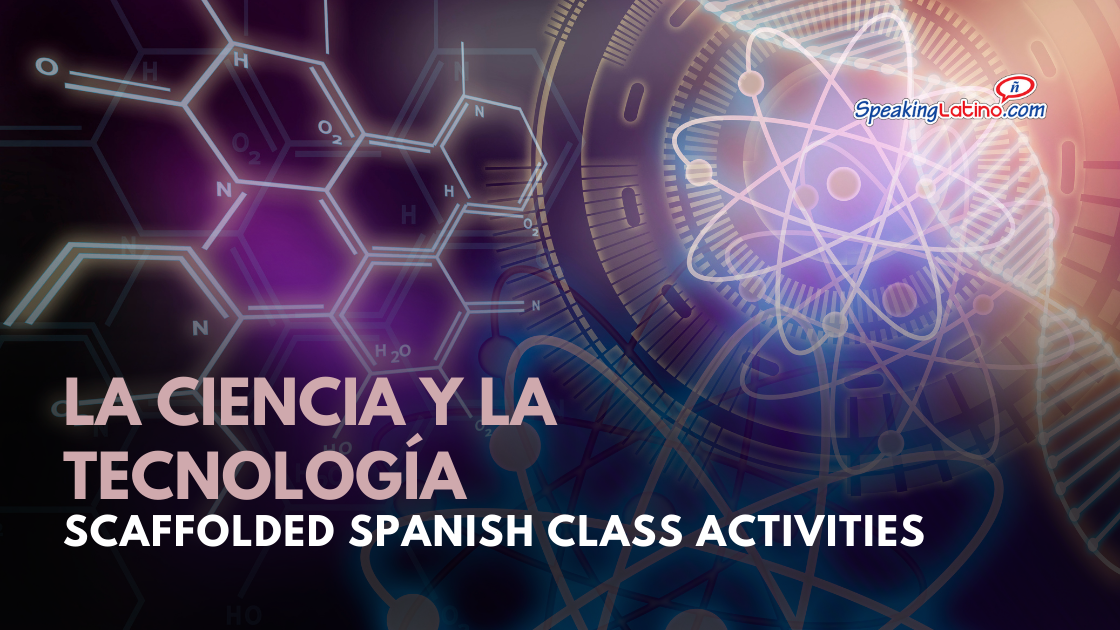
Ask your students how science and technology have shaped different cultures and societies around the world. And then present them with any of these cultural activities to take them on a journey through time and space to explore the fascinating intersection of science, technology, and culture.
The activities encourage students to think critically, analyze information, express opinions, and engage in debates. By prompting students to reflect on the cultural implications of scientific and technological advancements in different countries, the activities foster a deeper appreciation and understanding of cultural diversity.
Using One Material with All Proficiency Levels
These cultural activities are structured and designed to cater to students of different proficiency levels, providing scaffolded support to enhance learning and engagement. So, if you teach multiple levels or heritage speakers, or have a mixed classroom, these activities are a right fit.
- Different Levels: Each activity comes in three versions -Novice, Intermediate Low/Mid, and Intermediate High/Advanced. So, no matter where you're at with your students, there's something for everyone.
- Progressive: The activities start off easy and then ramp up the challenge as they move through the levels. It's like leveling up in a video game, but with Spanish!
- Variety: You'll find all sorts of tasks in these activities - reading, vocab stuff, answering questions, sharing your thoughts, and chatting with your classmates. Keeps things interesting, you know?
- Real-Life: These activities are all about real experiences from Spanish-speaking countries. It's like taking a mini trip through culture and language without leaving your classroom.
- Integration of AP Themes: Your students get exposed to those fancy AP themes right from the start. No need to wait around - dive into the good stuff early on. This integration helps demystify the AP level and shows students that they can engage with challenging content from the start.
- Teacher Support: Each activity includes the teacher's notes for each proficiency level and an answer key, providing you with guidance on how to implement the activities effectively and assess student understanding.
- Authentic: The activities use real stuff like articles, tweets, and pictures. It's like getting a glimpse into how Spanish is used in the real world.
The tasks included in the activities often involve interactive elements such as group discussions, role-playing, and collaborative projects. These interactive components encourage students to engage with diverse perspectives, share their own insights, and learn from their peers, fostering a sense of shared learning and cultural exchange.
La ciencia y la tecnología: 14 Scaffolded Cultural Activities
Tecnología de la Información – Efectos de la tecnología en sí mismo y en la sociedad
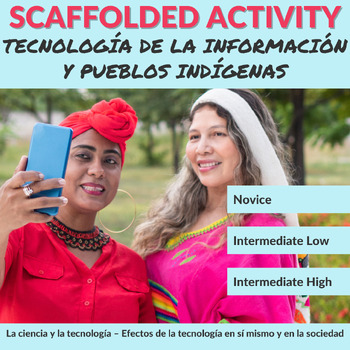
Audiovisual interpretive communication activity where students learn how technology and social media is revitalizing indigenous culture and language.
- Novice students focus on basic vocabulary to understand the central idea of indigenous technology use, practice reading and guessing strategies, learning new words, and exploring the impact of technology on indigenous communities.
- Intermediate Low/Mid students identify key words, answer comprehension questions related to the fusion of art and technology in indigenous contexts, exploring the significance of language preservation, and analyzing the role of influencers in promoting indigenous cultures through social media platforms.
- Intermediate High/Advanced students create presentations on indigenous influencers, comparing their content with mainstream influencers, analyzing the use of native languages in social media, identify indigenous influencers in their own country, evaluate the cultural impact of these influencers, and generate content suggestions or questions for them.
You can use this activity any time during the school year or around specific dates like:
International Day of the World’s Indigenous Peoples or Día de los Pueblos Originarios (August 9th) o Indigenous People’s Day or Día de los Pueblos Indígenas (Colombus Day).
Luis von Ahn y Duolingo – Las innovaciones tecnológicas

In this reading comprehension activity, students read about the founder of Duolingo, how the platform started, and how the method was designed.
Why your students will ❤️ this activity:
They will learn about a successful professor who created a new method to study languages that many of them have used in class and they will talk about why they like it or not. They can even try the app to support their ideas!
- Novice students read part of an article published recently on BBC Mundo about Duolingo and its founder, Luis von Ahn, learn new words in context, and tell their partners what they understood from the article.
- Intermediate Low/Mid students answer questions written in English, match Spanish and English verbs, and tell their classmates what other information they understood.
- Intermediate High/Advanced students answer questions written in Spanish, talk about the app, and give their opinion about it.
Bonnie Prado Pino: Ingeniera Aeroespacia – El acceso a la tecnología
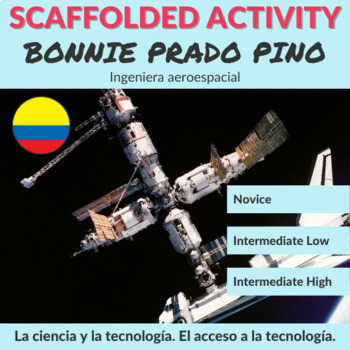
With this reading Reading comprehension, question formation, and speaking activities students learn about Bonnie Prado Pino, an Astrodynamics Engineer from Colombia.
- Novice students read a short interview about Bonnie Prado and do an oral discussion with a classmate to answer the reading comprehension questions. They also match the question words in Spanish and English and write additional questions they would like to ask Bonnie in an interview.
- Intermediate mid/low students read Bonnie’s interview and write 3 additional questions to add. They also work on a personal interview about their future career plan.
- Intermediate high/advanced students read an article about Bonnie Prado and her Afro-Latino Experience Organization. Then, they work on an interview and article writing assignment.
Puente de la Amistad en Paraguay – Tecnología, individuo y sociedad

In this visual activity, students learn about Puente de Amistad, a bridge that connects Paraguay with Brazil, its places of interests, and activities.
Why your students will ❤️ this activity:
Students read about two countries and their cultural exchange and will enjoy learning how a bridge can change the life of people around it!
- Novice students read an article, identify vocabulary by matching pictures, and answer simple questions.
- Intermediate Low/Mid students read a more detailed article, identify the attractions looking at images, and answer questions in Spanish.
- Intermediate High/Advanced students read the complete article and answer elaborate questions giving their opinion about the impact of construction on the environment.
Represa de Itaipú en Paraguay – Tecnología, individuo y sociedad
 In this reading comprehension activity, students learn and study about the Represa de Itaipú, a dam in Paraguay, and why it is so important for the community. They will be fascinated by learning the importance of dams.
In this reading comprehension activity, students learn and study about the Represa de Itaipú, a dam in Paraguay, and why it is so important for the community. They will be fascinated by learning the importance of dams.
- Novice students read an extract from an article, identify cognates, and answer simple questions about their understanding.
- Intermediate Low/Mid students learn new vocabulary related to the dam, and talk with a partner giving their opinion.
- Intermediate High/Advanced students read the complete article and answer questions explaining their point of view about different aspects of the dam.
Satélite Quetzal 1 – Las innovaciones tecnológicas
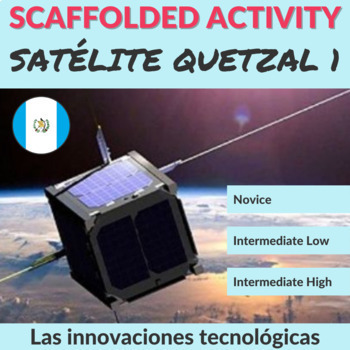
In this Visual Interpretation activity, students read and learn about the first satellite launched in Guatemala by looking at an official Government announcement and reading an article.
Why your students will ❤️ this activity:
Your students will see how a satellite launch is performed, and will learn the great amount of information an announcement can display. After this visual interpretation and reading comprehension activity, we are sure they’ll want to explore Space!
- Novice students are encouraged to elicit information from a visual announcement by the Presidency, read a short extract from the official article in the Simple Present Tense, and answer detailed information about the event.
- Intermediate Low/Mid students read the extract in the Simple Past Tense, speak about the event details, and learn the Guatemalan symbols.
- Intermediate High/Advanced students read the complete newspaper article as part of a comprehension activity, speak about similar past events, and discuss the importance of scientific and technological innovations.
Estudiantes cubanos compiten en programación – El acceso a la tecnología
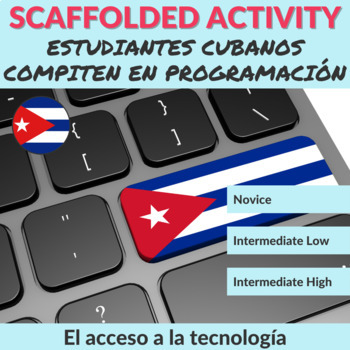
In this reading comprehension activity, students read about Cuban students who participate in an international programming contest called Scratch.
Why your students will ❤️ this activity:
Students will discover how coding and programming can improve mental skills.
- Novice students read the text and complete with the given missing words, learn vocabulary in context, and identify cognates.
- Intermediate Low/Mid students also think and talk about the importance of working and studying hard to accomplish objectives.
- Intermediate High/Advanced students read the complete text and write a persuasive essay explaining the authors’ and their own points of view.
Tecnología en la educación – Tecnología, individuo y sociedad

In this reading comprehension and visual interpretation activity, students discuss the effect of the pandemic and how the new technological tools are changing their lives.
Why your students will ❤️ this activity:
This Reading and Visual Comprehension activity will make your students think about how their present life has changed and compare it to life before the pandemic. It is a great opportunity to exchange opinions and debate!
- Novice students read a text about the technological tools at school and look at a poster to answer questions written in English. They also give their opinion in a form of an interview about the new life during the pandemic.
- Intermediate Low/Mid students answer the questions in Spanish and express their opinion about the pandemic effects.
- Intermediate High/Advanced students write an interview based on the information from the text and role-play the interviews with their classmates. They also develop the topic by debating about the advantages and disadvantages of the new technologies.
Covid-19 en Guatemala – Las innovaciones tecnológicas
 In this Reading Comprehension activity, students read about measures the Guatemalan Government is taking to protect the population from COVID-19.
In this Reading Comprehension activity, students read about measures the Guatemalan Government is taking to protect the population from COVID-19.
Why your students will ❤️ this activity:
Students will find this Reading Comprehension activity interesting because it is about an actual topic that is affecting the world right now; they will also learn about the Government of Guatemala and Guatemalan culture, and will interpret graphics and charts with information.
- Novice students read an official chat and see street signs designed by the government and then answer questions written in English.
- Intermediate Low/Mid students are asked to create their own street sign in Spanish to prevent the COVID-19.
- Intermediate High/Advanced students read an article published recently in a Guatemalan newspaper, look at charts and graphics with official information about the COVID-19, and then answer questions and give their opinion.
Carros antiguos en Cuba – El acceso a la tecnología
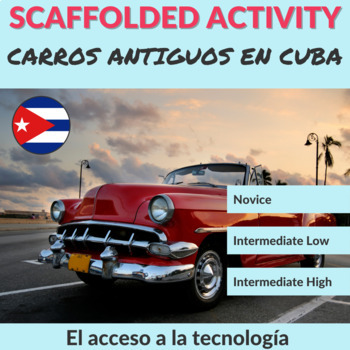
In this Reading Comprehension and Speaking activity about old Cuban cars, students learn why there aren’t new cars in the country by reading an online forum.
Why your students will ❤️ this activity:
Students will love reading and speaking about the odd cars from Cuba and the country’s story, which makes it a very unique and attractive place!
- Novice students describe the Cuban cars in the pictures, compare them to the cars from their cities, and talk about their preferences.
- Intermediate Low/Mid students are asked to answer questions, compare the cars from other countries, and give their opinions about the economical and political situation.
- Intermediate High/Advanced students talk for two minutes about their ideas after reading the complete text and looking for information on the Internet.
Acceso al internet en Cuba – El acceso a la tecnología

In this reading comprehension activity, students learn about the Internet in Cuba, how it started, and what impact it has on the society.
Why your students will ❤️ this activity:
Students will reflect on how different their life without the Internet could be!
- Novice students read an article and match the titles to the paragraphs.
- Intermediate Low/Mid students also answer questions written in Spanish, and discuss with a partner how important the Internet is and how they use it in everyday life.
- Intermediate High/Advanced students make a poster to promote a campaign to create awareness about the challenges Cuban people face.
Presidente Miguel Díaz-Canel – El acceso a la tecnología
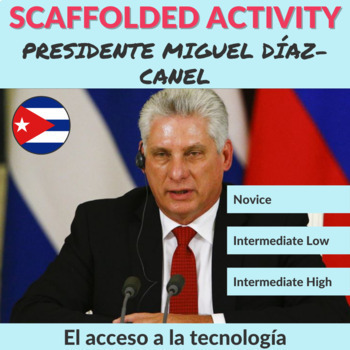
In this reading comprehension activity, students read about the President of Cuba, Miguel Díaz-Canel, how the new government faced the country’s issues, and what are its goals.
Why your students will ❤️ this activity:
Students give their opinion on how important it is for political figures to have a presence on social media.
- Novice students read an article and an official Tweet posted, and answer questions written in English.
- Intermediate Low/Mid students answer the questions written in Spanish.
- Intermediate High/Advanced students read a more detailed article, answer questions, and give their opinions based on what they read about the future of technology in the country.
Los Saltos del Monday – Los fenómenos naturales
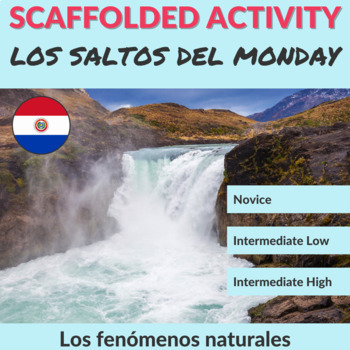
In this reading comprehension activity, students learn about Saltos del Monday, one of the wonders of Paraguay.
Why your students will ❤️ this activity:
Students discover one of the wonders of Paraguay by reading and looking at pictures. They will be curious to learn more about the indigenous communities introduced in the text!
- Novice students read a text describing the tourist attraction, identify cognates, and answer questions written in English.
- Intermediate Low/Mid students read a more detailed article with specific information, and answer questions in Spanish.
- Intermediate High/Advanced students read the complete article, and write a thank-you email to their teacher.
Tikal – Las innovaciones tecnológicas

In this reading comprehension activity, students read about Tikal, a Mayan Civilization in Guatemala, learn about their culture, and the archeological discoveries.
Why your students will ❤️ this activity:
This activity transports your students into the past of a rich and inspiring culture, which was declared a World Heritage Site by UNESCO.
- Novice students read an article published on the internet about Tikal, learn new words in context, and answer questions written in English.
- Intermediate Low/Mid students read a more detailed text and answer questions written in English.
- Intermediate High/Advanced students read a more extensive article with detailed information about the civilization and their story, and answer questions written in Spanish.
Endless Options to Explore More Cultural Themes
Explore the additional set of activities to enrich your Spanish classes with a wider range of cultural topics tailored to every proficiency level.
1. La belleza y la estética - Activities tailored to different proficiency levels, exploring diverse cultural topics related to beauty, aesthetics, and heritage in Argentina, Colombia, and Ecuador. Through a combination of reading comprehension, vocabulary building, and critical thinking exercises, students enhance their Spanish language skills while gaining valuable insights into the richness of Spanish-speaking cultures.
2. La Identidad Pública y Privada - These suggested activities designed around the AP Spanish theme of La identidad pública y privada or public identities in the Spanish-speaking world, but they have been also adapted for students at novice and intermediate proficiency levels.
3. La Vida Contemporánea - This set of activities cover cultural topics such as canopy tours in Monteverde, Costa Rica, bullfighting in Spain, Antonio Gaudí’s architecture in Barcelona, and the Plaza de España. These topics offer insights into diverse aspects of Hispanic culture, fostering intercultural understanding and language proficiency among students.
4. Las Familias y las Comunidades - Dive into traditions, values, and challenges faced by families and communities in the Spanish-speaking world with differentiated activities featuring Peru, Dominican Republic, Chile, and Uruguay.
5. La Ciencia y la Tecnología - Students engage in various activities that explore the theme of science and technology in Colombia, Paraguay, Guatemala, Cuba, and among indigenous communities.
6. Los Desafíos Mundiales - Explore global challenges across all student's level with these activities featuring Puerto Rico and Equatorial Guinea. They will get to explore topics like natural disasters, environmental conservation, social challenges, and cultural aspects. It's all about real-world issues while improving their Spanish skills.
7. Afro-Latinos Scaffolded Cultural Activities - Use these scaffolded activities in any order during Black History Month or through the school year. Each activity includes 3 versions to use with novice, intermediate low-mid, and intermediate high-advanced students.